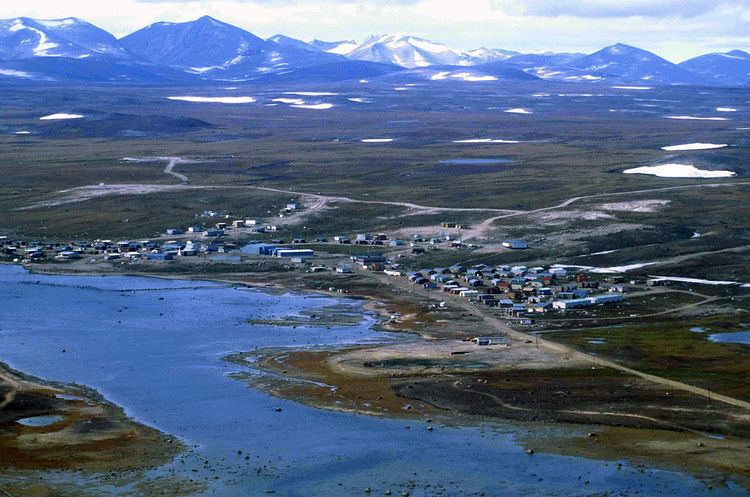Country Canada Time zone EST (UTC-5) Area 106.5 km² Population 1,053 (2016) Area code 867 | Canadian Postal code X0A 0E0 Elevation 27 m Local time Tuesday 2:17 PM Number of airports 1 | |
 | ||
Weather -23°C, Wind W at 5 km/h, 61% Humidity | ||
Clyde River (Inuktitut: Kanngiqtugaapik, Syllabics: ᑲᖏᖅᑐᒑᐱᒃ) is an Inuit hamlet located on the shore of Baffin Island's Patricia Bay, off Clyde Inlet, an arm of Davis Strait in the Qikiqtaaluk Region, of Nunavut Canada. It lies in the Baffin Mountains which in turn form part of the Arctic Cordillera mountain range. The community is served by air and by annual supply sealift.
Contents
Map of Clyde River, NU, Canada
The community is served by Quluaq School, the Northern Stores, an arena, a community hall, an Anglican church (the Church of the Redeemer,) a health centre, hotel and Clyde River Airport with regular flights to Iqaluit and Pond Inlet.
Demographics
At the 2016 census the population was 1,053 an increase of 12.7% from the 2006 census. About half of the people here are under the age of 18 and the population is growing rapidly.
Geography
It is located on a flood plain, surrounded by spectacular fiords that stretch all the way into the Barnes Ice Cap. The mountains, icebergs and glaciers in the Clyde River area attract rock and ice climbers from around the world.
There is also a multitude of animals to be seen, including barren-ground caribou, narwhals, polar bears and other sea mammals. The proposed "Igaliqtuuq National Wildlife Area", which would be a protected bowhead whale sanctuary, is located in Isabella Bay.
Clyde River is home to Piqqusilirivvik, Nunavut's Inuit Cultural Learning Centre. Piqqusilirivvik opened its doors May 2011.
Supreme Court Case
On June 26, 2014 the National Energy Board (NEB) approved the 5-year plan to conduct seismic blasting off the coast of Baffin Island, Nunavut, jointly submitted by TGS-NOPEC Geophysical Company ASA (TGS), Petroleum GeoServices (PGS) and Multi Klient Invest AS (MKI). The approval sparked strong criticism from Inuit including the communities of Clyde River and Pond Inlet, the Arctic Fishery Alliance, the Baffin Fisheries Coalition and the Qikiqtani Inuit Association. Okalik Eegeesiak, then-president of the Qikiqtani Inuit Association said “They still don't get the fact that Inuit have concerns and we want to be part of the process,” while Inuit photographer and Clyde River resident Niore Iqalukjuak was quoted saying "We depend on these waters for food and the very existence of Inuit life depend on them...We fear that what the Conservative government is doing is a cultural genocide and will end the Inuit way of life as we know it" and Clyde River Mayor Jerry Natanine commented “Nobody cares for our concerns...And our Minister [of the Environment] in Ottawa, Leona Aglukkaq, not speaking up against this for Inuit is very wrong.”
Mayor Natanine approached the environmental organization Greenpeace Canada in hopes that they could work together to prevent seismic blasting operations from taking place. This led to the development of a collaboration many dubbed "surprising" due to the long history of Inuit distrust of Greenpeace and other environmental groups.
On July 23, 2014, the community of Clyde River staged a protest against the NEB’s approval, and on July 28 the Hamlet of Clyde River, the Nammautaq Hunters and Trappers Organization of Clyde River, and Clyde River Mayor Jerry Natanine filed a request for a judicial review at Federal Court of Appeal. The legal case argues that the NEB’s decision goes against the government of Canada’s duty to consult with Indigenous Peoples under the United Nations Declaration on the Rights of Indigenous Peoples. Speaking of the importance of the case, constitutional lawyer Nader Hasan, who is representing Clyde River, argued: “The federal government has a solemn constitutional obligation to meaningfully consult and accommodate the people of Nunavut on any issues affecting their Aboriginal or treaty rights. That didn’t happen here. Once again, the NEB was a rubber stamp for the energy industry.”
The Court of Appeal denied the request in August 2015. But the groups requested leave to appeal before the Supreme Court of Canada in October 2015, arguing that the Court of Appeal’s decision was mistaken, and that the case is of national importance, thus needing further debate. In November of the same year Greenpeace launched an international petition that has gathered over 129,000 signatures (as of July 2016) in support of this legal challenge.
On March 10, 2016 the Supreme Court of Canada granted Clyde River leave to appeal their case at the country’s highest court, giving credence to the community’s claim that their case is significant, thus needing further review by the courts. The hearing of the case has been scheduled for November 20, 2016.
